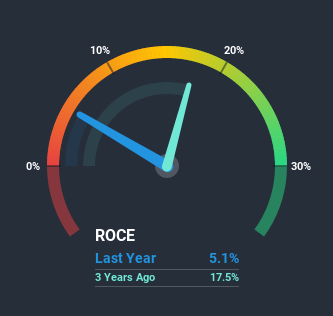- Taiwan
- /
- Semiconductors
- /
- TPEX:5315
Will United Radiant Technology (GTSM:5315) Multiply In Value Going Forward?
What trends should we look for it we want to identify stocks that can multiply in value over the long term? One common approach is to try and find a company with returns on capital employed (ROCE) that are increasing, in conjunction with a growing amount of capital employed. Ultimately, this demonstrates that it's a business that is reinvesting profits at increasing rates of return. Although, when we looked at United Radiant Technology (GTSM:5315), it didn't seem to tick all of these boxes.
What is Return On Capital Employed (ROCE)?
For those who don't know, ROCE is a measure of a company's yearly pre-tax profit (its return), relative to the capital employed in the business. Analysts use this formula to calculate it for United Radiant Technology:
Return on Capital Employed = Earnings Before Interest and Tax (EBIT) ÷ (Total Assets - Current Liabilities)
0.051 = NT$71m ÷ (NT$1.8b - NT$368m) (Based on the trailing twelve months to September 2020).
Therefore, United Radiant Technology has an ROCE of 5.1%. Ultimately, that's a low return and it under-performs the Semiconductor industry average of 10%.
Check out our latest analysis for United Radiant Technology

Historical performance is a great place to start when researching a stock so above you can see the gauge for United Radiant Technology's ROCE against it's prior returns. If you're interested in investigating United Radiant Technology's past further, check out this free graph of past earnings, revenue and cash flow.
What Does the ROCE Trend For United Radiant Technology Tell Us?
When we looked at the ROCE trend at United Radiant Technology, we didn't gain much confidence. To be more specific, ROCE has fallen from 29% over the last five years. Meanwhile, the business is utilizing more capital but this hasn't moved the needle much in terms of sales in the past 12 months, so this could reflect longer term investments. It may take some time before the company starts to see any change in earnings from these investments.
On a related note, United Radiant Technology has decreased its current liabilities to 21% of total assets. So we could link some of this to the decrease in ROCE. What's more, this can reduce some aspects of risk to the business because now the company's suppliers or short-term creditors are funding less of its operations. Since the business is basically funding more of its operations with it's own money, you could argue this has made the business less efficient at generating ROCE.What We Can Learn From United Radiant Technology's ROCE
To conclude, we've found that United Radiant Technology is reinvesting in the business, but returns have been falling. And in the last five years, the stock has given away 14% so the market doesn't look too hopeful on these trends strengthening any time soon. On the whole, we aren't too inspired by the underlying trends and we think there may be better chances of finding a multi-bagger elsewhere.
Since virtually every company faces some risks, it's worth knowing what they are, and we've spotted 4 warning signs for United Radiant Technology (of which 1 is significant!) that you should know about.
For those who like to invest in solid companies, check out this free list of companies with solid balance sheets and high returns on equity.
If you’re looking to trade United Radiant Technology, open an account with the lowest-cost* platform trusted by professionals, Interactive Brokers. Their clients from over 200 countries and territories trade stocks, options, futures, forex, bonds and funds worldwide from a single integrated account. Promoted
New: AI Stock Screener & Alerts
Our new AI Stock Screener scans the market every day to uncover opportunities.
• Dividend Powerhouses (3%+ Yield)
• Undervalued Small Caps with Insider Buying
• High growth Tech and AI Companies
Or build your own from over 50 metrics.
This article by Simply Wall St is general in nature. It does not constitute a recommendation to buy or sell any stock, and does not take account of your objectives, or your financial situation. We aim to bring you long-term focused analysis driven by fundamental data. Note that our analysis may not factor in the latest price-sensitive company announcements or qualitative material. Simply Wall St has no position in any stocks mentioned.
*Interactive Brokers Rated Lowest Cost Broker by StockBrokers.com Annual Online Review 2020
Have feedback on this article? Concerned about the content? Get in touch with us directly. Alternatively, email editorial-team@simplywallst.com.
About TPEX:5315
United Radiant Technology
Manufactures and sells liquid crystal display panels and modules.
Flawless balance sheet with solid track record.
Similar Companies
Market Insights
Community Narratives



